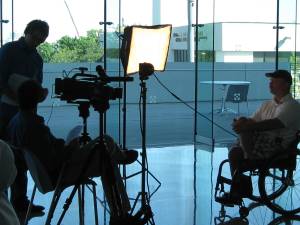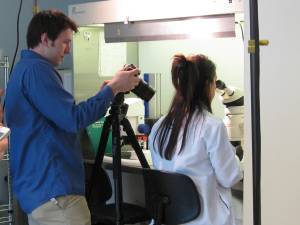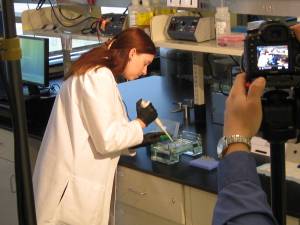A Note from Christopher Fasano, Ph.D. :
——————–
I have organized a different kind of stem cell meeting in May, the Next Gen Stem Cell Conference, at the beautiful Saratoga National Golf Club in historic Saratoga NY. More than 10 young investigators from institutions including, Harvard Stem Cell Institute, Johns Hopkins, Cornell Medical College and more are scheduled to talk. The conference will include some very informative sessions, not only on stem cell research but also research tools and the use of social media in our industry. Sessions will cover:• Embryonic stem cell maintenance and differentiation
• iPSC generation
• Neural stem cells
• Online marketing including the use of social media (from an online marketing expert)
• Information on a reagent that can enhance your stem cell researchMost importantly, we plan to have a lot of fun! Saratoga in May is beautiful, and this golf club is fantastic. Included in the affordable registration fee are two lunches, one breakfast, and a great dinner with an open bar. That open bar will be outside on a beautiful patio overlooking the 18th hole with live music.
Right now until registration closes this Friday, if you register, you will be entitled to bring along a friend and/or labmate for no additional charge.
Simply visit the conference website, register, and then send me an email atchrisfasano@stemcultures.com with the name of the second person that will be attending with you. Here is the website: http://www.NextGenStemCell.com
To Successful Research,
Christopher Fasano, Ph.D.
Chief Operating Officer
StemCultureConsistent, high-quality reagents created by stem cell scientists.
Help US Save the NYS Spinal Cord Injury Research Program!
Please send the following information to your friends and colleagues, with your email explaining why it’s important. Ask them to send it on. Let’s reach as many and as far as we can:
Letter writing campaign:
Save the NYS Spinal Cord Injury Research Program! Attached here Reinstate SCIRP funding Letter is a letter to use as a guide, addresses to send the letters to here addresses for SCIRP letter , a fact sheet about the spinal cord injury research program Fact Sheet SCIRP 2013 and two of the press articles NYPost Feb 13 2013 and TU Feb 14 End sweep of spinal cord funds. Snail mail is most effective, headed paper is great if you can. Please send letters right away, this week through Feb 22nd is critical!
Take these steps:
1) Open the attached letter and read it. If you want, edit it. Perhaps add your personal reasons why SCIRP should be reinstated.
2) Print, sign the letter and address the envelope to those on the attached list, and especially:
Hon. Andrew M. Cuomo
Executive Chamber
State Capitol
Albany, NY 12224
Hon. Nirav Shah, M.D., MPH
Office of the Commissioner
NYS Department of Health
Corning Tower
Empire State Plaza
Albany NY 12237
3) Stamp and Send the letter.
Three easy steps and you will have given us a wonderful gift.
Phone-in campaign:
To call Governor Andrew Cuomo, call the CITIZEN SERVICES UNIT at 518-474-1041 and say “My name is xxxxxx, I am calling to urge the governor to amend his 2013-2014 budget to include funding for the NYS spinal cord injury research program.” You can add more, but that is sufficient.
And to reach the Commissioner of Health, Dr. Nivav Shah, at the Department of Health, the phone number is 518-474-2011 and the email address is dohweb@health.state.ny.us
We will have a Facebook page up and running soon.
Thank you again for your continued support! It means the world to us!
NY Spinal Cord Research Needs Your Help!
NY Spinal Cord Research Needs Your Help!
In 1998 New York made history by being the first state to pass legislation designating a surcharge on motor vehicle violations to fund spinal cord injury research. Now that funding is in jeopardy as the proposed budget diverts this money elsewhere. Significant research progress has occurred because of these research grants – New Yorkers need our help to make sure they aren’t taken away.
There are two ways you can help:
1. Write to Governor Cuomo and explain how essential this funding is to people with spinal cord injuries and their families. Tell your personal story. Letter should be one-page.
Send to :
The Honorable Andrew M. Cuomo
Governor of New York
State Capitol Building
Albany, New York 12224
2. Attend the special program scheduled February 13th at the state capitol in Albany.
Hear the latest in research and add your voice to the cause.
For details, send your name and email to Keith Gurgui: kgurgui@hotmail.com.
Meeting Of Research and Clinical Leaders, Advocates, and Patients To Highlight The Need To Reinstate Spinal Cord Injury Research Funding In New York State
MEETING OF RESEARCH AND CLINICAL LEADERS, ADVOCATES, AND PATIENTS TO HIGHLIGHT THE NEED TO REINSTATE
SPINAL CORD INJURY RESEARCH FUNDING IN NEW YORK STATE
NYS has a unique and extremely productive Spinal Cord Injury Program (SCIRP) funded through a surcharge on traffic-ticket moving violations. From 1998 through 2009, SCIRP provided 70 million dollars for research in treatments for spinal cord injury. This investment produced important scientific advances and brought significant additional funding into NYS. However, since 2010, this money raised for paralysis research has been diverted to other unrelated purposes. We come together to urge NYS to reinstate this essential funding stream.
Location: Empire State Convention Center
Meeting Rooms 2 & 3, S. Mall Arterial, Albany NY 12242
Time: 9:00 a.m.-5:15 p.m. with PRESS CONFERENCE at 1:00p.m.
Registration Required:
Email Event Coordinator Cindy Butler at cindybutler@nynsci.org
or call 518-694-8188 by February 11th
Register Early, space limited. Wheelchair accessible.
Lunch provided; $40 donation for meeting suggested
Directions and Parking: Visit http://ogs.ny.gov/ESP/CCE
NYS Senator Kirsten Gillibrand Visits NSCI
Last Thursday, we were privileged enough to be visited by NYS Senator Kirsten Gillibrand. During her visit, she announced a bill which would aim at stimulating private investment in local research facilities.
The America Innovates Act of 2012 (S. 2369) “creates a bank which is aimed to help universities and institutions turn scientific ideas into commercialized products that will attract private investment and the critical capital which is needed to commercialize,” said Gillibrand. “Many of our universities and research institutions lack the resources they need to take a scientific breakthrough into a high-tech job or a high-tech product.”
Specifically, the bill would create an independent agency, the American Innovation Bank, with the ability to direct loans and grants to non-profit research organizations, individual researchers, and private companies.
During a small press conference held in the building our Director of Research and Development, Dr. Chris Fasano, was asked to speak. Here are his opening remarks.
The ultimate goal of biomedical research is translating basic
discoveries into therapeutics for sick patients. For years, state
and federal grants have done a tremendous job establishing a
rich pipeline of discovery in all fields of biomedical science.
However, programs for the translation of these discoveries have
not been so abundant and this gap, better known as”The Valley of Death”, is a critical roadblock for the successful transition from bench to bedside.
In 2007, Dr. Sally temple and Dr. Jeffery Stern
founded this institute — the first independent stem cell institute in
the country — to be an oasis in “The Valley of Death” for the
successful translation of neural stem cell discoveries.
The east campus of the University of New York at Albany was an easy choice for a location due to its integration of academic labs, core facilities, and small companies.
Administratively lean, but rooted in academic research, NSCI can
be nimble and autonomous in its decisions on how best to take
the discovery out of the lab and into clinical trials. Just like most
academic institutions, NSCI is dependent on federal and state
grants, and has been quite successful securing funds through the
years.
With this, we have made key discoveries including a
potential drug to combat macular degeneration, as well as a small
time-released system to implant into injured spinal cords to
promote regeneration. While our results show tremendous
promise, big pharmaceutical companies do not take risks at such an early stage, and will not invest until the product is much further developed, typically costing 10s to100s of millions. — a cost too much for us to bear.

NSCI Director of Research and Development, Dr. Christopher Fasano, gives his opening remarks as NYS Senator Kirsten Gillibrand looks on.
We sincerely thank Senator Gillibrand for taking the time to visit our institute and speak with us.
This post comes to you from Rachel Wurster. Research technician by day, social media guru by midday and on some rare occasions evenings.
NSCI First Video
Remember that Behind the Scene blog a while ago about our first video shoot. Well ….. drum roll please ….. it’s finally here and ready for your viewing. We here at NSCI would again like to thank Modern Mix Marketing for putting this together for us. We hope you find this video insightful and get a glimpse into our wonderful Institute. Enjoy!
Click Below!
Neural Stem Cell Institute Video
The Central Nervous System, It’s Kind of a Big Deal
Here at the Neural Stem Cell institute (NSCI), we’ve made it our mission to help create therapies that will help in repairing damage to the central nervous system. So why is the nervous system so important? Why study it?
The central nervous system (CNS) includes the brain, spinal cord, and retina as well as a complex system of nerves. Not only is the CNS the first system in the body to develop, it also reigns supreme and controls almost every action within the body. Whether it is moving your fingers to press keys on a keyboard (like I am currently demonstrating), having a conversation with a friend, or commanding the cells required for growth, maintenance and healing of an injury, the CNS is the command center.
We have chosen to devote our time to studying the CNS because it is incapable of healing itself in the way other tissues do, such as the skin. Because of this, damage or disease in the CNS is often permanant. We believe that neural stem cells (NSCs) hold great promise for regenerative therapy for damaged CNS. The ability to regenerate neurons and the supporting glial cells, such as oligodendrocytes, has applications in helping many diseases and injuries of the CNS. Ever since our scientists at NSCI discovered CNS stem cells in 1989, we have aimed to harness the regenerative power of neural stem cells to ease suffering caused by injury and disease. The implications of this research are far-reaching.
Much of our research focuses on the NSCs that lie dormant in our nervous systems. These are stem cells that were active long ago when you were still a twinkle in your mother’s eye. These dormant cells can be activated to mediate repair and regeneration in lower animals that do have the capability to regenerate brain tissue or even re-grow an eye. Equivalent cells are present in humans, but they just need a swift kick to get them going again. The NSCs that accomplish such remarkable repair are inhibited in higher animals like humans or mice but can be activated by injecting stem cell growth factors. We have found that implanting growth factor releasing microbeads (adding a few extra ingredients to the pot so to speak) helps improve the ability of spinal cord injured mice to walk. The microbeads help to activate the resident dormant stem cells and aid repair of the injury. How cool is that! We are working to apply such skills to a variety of injuries and diseases that damage our CNS.
NSCI scientists have also discovered a new kind of NSCs in the adult retinal pigment epithelium (RPESC), which can be used for autologous transplantation (cells are removed and then placed back into the same individual after some tweaking). These cells are likely to be beneficial for Macular Degeneration, Retinitis Pigmentosa, and even for nervous system disorders outside the retina. These RPESC are also used to develop disease models for drug discovery.
Just look at all the interesting things the CNS can do. We only need to learn how to harness its power more fully. With continued hard work and creativity we believe we can help the human CNS repair itself!
This post comes to you from Rachel Wurster. Research technician by day, blogger and tweeter extraordinaire by midday.
Comment Corner
Are you or anyone you know affected by disease or damage of the CNS? Tell us your story.
What’s your favorite thing about the CNS?
Erzsi’s Goodbye Luncheon
Our dear friend and colleague Erzsebet Kokovay will be leaving us this week to head her own lab at the University of Texas Health Sciences Center at San Antonio. She has even received their prestigious Rising Star grant which provides extra start up money for promising new investigators. Even though we are sad to see Erzsi go, we are truly happy for this exciting new phase of her career. We wish her the very best. I’ve included some photos of her farewell party below.
Behind The Scenes of Our First Video Shoot
Exciting stuff is happening here at The Neural Stem Cell Institute! We just had our first shoot for a fundraising video for the Institute. Featured were Dr. Sally Temple, Dr. Jeff Stern, Chris McMahon, and Dr. Christopher Fasano. We would particularly like to thank Chris McMahon for coming by to share his inspirational story with us. I’ve included some exclusive behind the scenes photo below. Stay tuned!

The nice folks from Modern Mix Marketing (http://modernmixmarketing.com/) setting up for the shoot.
This post comes to you from Rachel Wurster. Research technician by day, blogger and tweeter extraordinaire by midday.
5 Ways You Can Help “Culture” Stem Cell Research
“How can you help?” Well I’m so glad you asked. Here are a few ways you can lend a hand. No pressure but there will be a test at the end.
1. Make a Donation
Donations are always the easiest and most expedient way to get the ball rolling in any lab. Many people may not realize this but science is expensive. Funding from NIH and other organizations are getting more and more competitive meaning the chances of getting these highly sought after grants is shrinking. Donations accelerate the process of getting our discoveries here in the lab to new therapies for patients. Donations are important to any non-profit organization including ours.
To make a donation to the neural stem cell institute, please click here.
2. Tell A Friend
It is understandable that many people don’t have money to give. This doesn’t mean you can’t help and be part of something wonderful. By just helping your friends understand the role of stem cells and the potential they have for medical applications can increase support for our cause in this emerging area of biomedicine. Just simply slip it into conversation at your next dinner party and you will be well on your way. Instead of commenting on how lovely the weather is, simply comment on the lovely stem cell research that is going on in the world. Easy as pie.
3. Stay Informed
How will I be the most interesting person at my next fancy dinner party? Brush up on current stem cell research that’s how. Stem cell research is one of the fastest growing fields of scientific study, and it is leading to exciting new therapeutic options in the area of regenerative research. There has to be some information out there on this right? Conveniently enough there is. Our website www.nstemcell.org (not a plug I swear, well maybe a little one) has tons of information about the projects we are currently working on and the science behind it. The International Society for Stem Cell Research (www.isscr.org) also has some really great resources if you want to expand your knowledge on stem cell research. You don’t have to get your PhD in stem cell research, but if you know the basics you are golden. So the next time you are surfing the web check them out. Beware though; some sites on stem cell research are less fact and more fiction.
4. Volunteer
Handy with a pipette? Ask to volunteer at a local lab and get some hands on experience at the same time. Labs can always use another set of hands and an extra brain or two. It is also a great way to see how a lab environment truly is and if it is a place you can see yourself working at in the future. Another bonus, colleges and universities eat this stuff up when you’re applying. It’s a win-win situation for everyone involved.
5. Give a Scientist a Pat on the Back
Though we toil away for the good of humanity, a “thank you” or a “keep up the good work” goes a long way. It’s nice to know that you are doing a job well done and that your hard work is truly appreciated. Even a high-five means a lot and makes us work that much harder. Just make sure we take our gloves off first.
Alright are you ready for that quiz? Just checking. By just reading these suggestions on how to help you are already starting to make a difference. No matter which way you decided to aid in our ongoing endeavors, know that it is greatly appreciated. Isn’t it nice to be part of something so fantastic? Believe me, it does.
Comment Corner
If you are currently helping a scientist in need post your story below. Do you have any more suggestions on how people can help? How do you plan to help in the future? I can’t wait to hear from all of you!
This post comes to you from Rachel Wurster. Research technician by day, blogger and tweeter extraordinaire by midday.







